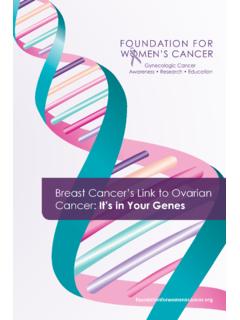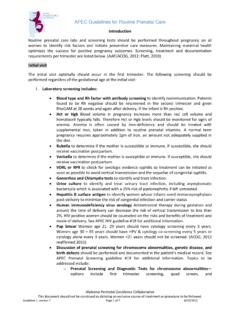Transcription of Understanding Endometrial Cancer
1 Understanding Endometrial CancerA WOMAN S ..1 Endometrial Cancer : An oVERVIEW ..2 RIsK FACtoRs ..2 MEDICAL EVALUAtIon ..3 WoRKInG WItH YoUR tREAtMEnt tEAM ..3tREAtMEnt ..5 IMPoRtAnCE oF PARtICIPAtIon In CLInICAL tRIALs ..10onCE YoU HAVE BEEn tREAtED, tHEn WHAt? ..10 RECURREnt DIsEAsE .. 10 LIVInG WItH Cancer tHERAPY ..11tIPs FoR CoPInG ..13 HoPEFUL MEssAGEs ..14 REsoURCEs FoR MoRE InFoRMAtIon ..15tAKE ACtIon tELL A FRIEnD! ..16 The Foundation for Women s Cancer is a 501(c) (3) not-for-profit organization dedicated to funding research and training, and ensuring education and public awareness of gynecologic Cancer prevention, early detection and optimal treatment. Understanding Endometrial Cancer 1 IntRoDUCtIonYou have received a diagnosis of Endometrial Cancer , sometimes called uterine Cancer . The amount of information you receive at the time of diagnosis can feel overwhelming.
2 All at once, you may feel there are many unanswered questions, decisions to be made and so much information to be team of healthcare professionals will work with you throughout your treatment process. Each of them has an important job, but the most vital member of the team is you. In order to play an active role during your treatment, you should try to learn as much about Endometrial Cancer as booklet will take you through the basics of what you need to know about Endometrial Cancer . It will introduce you to the people who may be part of your treatment team. Also, it will identify the different types of treatments for Endometrial Cancer . Hopefully this information will help prepare you to talk with your treatment team and to feel more confident about your treatment Understanding Endometrial CANCEREnDoMEtRIAL Cancer : An oVERVIEWC ancer occurs when cells in an area of the body grow Cancer is Cancer of the lining of the uterus (called the endometrium).
3 The uterus (or womb) is where a baby grows during pregnancy. The fallopian tubes on both sides of it connect it to the ovaries and the cervix connects it to the vagina. These reproductive organs are located in the pelvis, close to the bladder and endometrium is the inside lining of the uterus that grows each month during the childbearing years. It does this so that it will be ready to support an embryo if a woman becomes pregnant. If pregnancy does not occur, the endometrium is shed during the menstrual FACtoRsRisk factors for Endometrial Cancer include use of estrogen without progesterone, diabetes, hypertension, tamoxifen use and later age of menopause (after age 52). About 75% of women diagnosed with Endometrial Cancer have already gone through one of the strongest and most common risk factors for the development of Endometrial Cancer is obesity.
4 Women who are obese have higher circulating levels of estrogen, which increases their risk for Endometrial also plays a role in a small percentage of women with Endometrial Cancer . Some families have a high frequency of Endometrial , colon and ovarian Cancer . If you have relatives with Endometrial , colon and/or ovarian Cancer , you should see a genetics most common warning sign for uterine Cancer , including Endometrial Cancer , is abnormal vaginal bleeding. Recognition of this symptom often affords an opportunity for early diagnosis and treatment. In older women, any bleeding after menopause may be a symptom of Endometrial Cancer . Younger women are also at risk, and should note irregular or heavy vaginal bleeding as this can be symptoms of Endometrial Endometrial Cancer 3 Symptoms for Endometrial Cancer include: vaginal bleeding or spotting after menopause New onset of heavy menstrual periods or bleeding between periods A watery pink or white discharge from the vagina Two or more weeks of persistent pain in the lower abdomen or pelvic area Pain during sexual intercourseMEDICAL EVALUAtIonWhen a woman experiences concerning symptoms, a pelvic exam, including a rectogvaginal exam, and a general physical should be performed.
5 If the exam is abnormal, the woman should undergo an Endometrial biopsy, ultrasound and/or and a D&C (dilation and curettage) WItH YoUR tREAtMEnt tEAMD uring your treatment, you will come in contact with many healthcare professionals. These people make up your treatment team. They will work with each other and you to provide the special care you need. Your treatment team may include some of the healthcare professionals listed , your treatment will be provided and managed by a gynecologic oncologist. Gynecologic oncologists are board-certified obstetrician-gynecologists who have an additional three to four years of specialized training in treating gynecologic Cancer from an American Board of obstetrics and Gynecology-approved fellowship program. A gynecologic oncologist can manage your care from diagnosis to completion of treatment providing both surgery and drug therapies (chemotherapy).
6 Women with Endometrial Cancer who have their surgery done by a gynecologic oncologist have higher cure rates than women who have surgery done by another type of doctor. The better survival is related to the fact that gynecologic oncologists are more likely to remove all of the Cancer at the time of surgery. 4 Understanding Endometrial CANCERYou also may be treated by: Medical oncologist who specializes in using drug therapy (chemotherapy) to treat Cancer . Chemotherapy may also be given by your gynecologic oncologist. Radiation oncologist who specializes in using radiation therapy to treat Cancer . Oncology nurse who specializes in Cancer care. An oncology nurse can work with you on every aspect of your care, from helping you understand your diagnosis and treatment to providing emotional and social support. Social worker who is professionally trained in counseling and practical assistance, community support programs, home care, transportation, medical assistance, insurance and entitlements.
7 They are very helpful advocates, especially when you are first diagnosed and unsure what to do next. Nutritionist or registered dietician who is experts in helping you either maintain or initiate healthy eating habits. This is important in the recovery process. These professionals help you overcome potential side effects of treatment such as poor appetite, nausea or mouth sores. It is important to note that natural remedies and supplements should only be taken under the supervision of a naturopathic physician in consultation with your gynecologic with your treatment teamYou deserve expert advice and treatment from your treatment team. Be sure to talk openly about your concerns with the members of your treatment team. let them know what is important to you. If it is hard for you to speak for yourself, these tips may help: make a list of questions before your visit.
8 Ask the most important questions first. Take notes, or ask if you can tape record your medical office visits and phone conversations. If you don t understand something, ask the treatment team member to explain it again in a different way. If possible, bring another person with you when you meet with members of your treatment team to discuss test results and treatment Endometrial Cancer 5tREAtMEntEndometrial Cancer may be treated with surgery, radiation therapy, chemotherapy or hormonal therapy. Depending on your situation, your treatment team may recommend using a combination of treatments to treat your specific treatment plan will depend on several factors, including: The stage, grade and specific subtype (histology) of your Cancer The size and location of your Cancer Your age and general healthAll treatments for Endometrial Cancer have side effects.
9 Most side effects can be managed or avoided. Treatments may affect unexpected parts of your life including your function at work, home, intimate relationship, and deeply personal thoughts and beginning treatment, it is important to learn about the possible side effects and talk with your treatment team members about your feelings or concerns. They can prepare you for what to expect and tell you which side effects should be reported to them immediately. They can also help you find ways to manage the side effects you most common treatment for Endometrial Cancer is surgery. Several types of surgery can be : involves removal of the uterus and cervix and is the standard procedure for treating Endometrial Cancer . The uterus and cervix can be removed in one of three ways: Total abdominal hysterectomy: the uterus and cervix are taken out through an incision in the abdomen.
10 Radical abdominal hysterectomy: in addition to the uterus and cervix, the tissue next to the uterus and cervix, as well as part of the upper vagina, are also removed. Minimally invasive hysterectomy (laparoscopic-assisted vaginal hysterectomy and robotic total laparoscopic hysterectomy): the uterus and cervix are taken out through the vagina with the assistance of a laparoscope or robotic device (a small tube-like viewing instrument) that is placed through the abdomen via a small Understanding Endometrial CANCERFor those patients with multiple medical problems and who are not healthy enough to undergo an extensive surgical procedure, a vaginal hysterectomy can be performed. In most cases, both ovaries and both fallopian tubes must also be removed. This procedure is called a bilateral salpingo-oophorectomy. lymph nodes in the abdomen and pelvis may also be taken out to see whether they contain EFFECts oF sURGERYSome discomfort is common after surgery.











